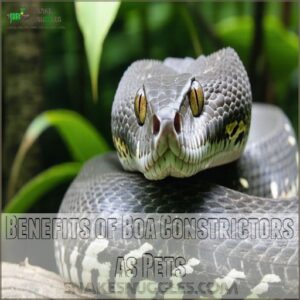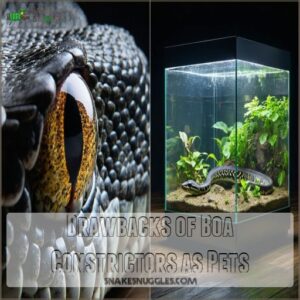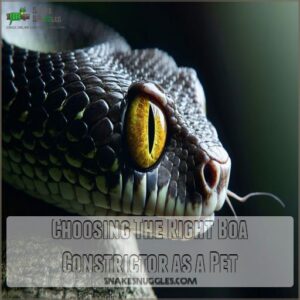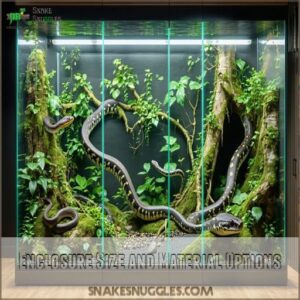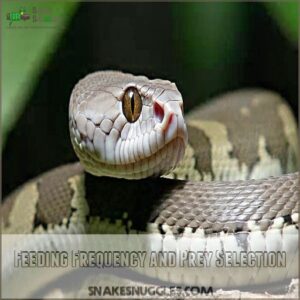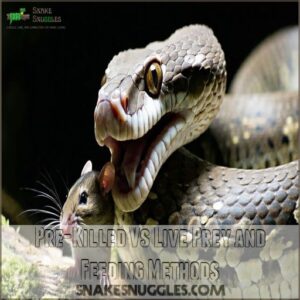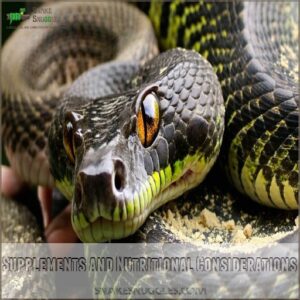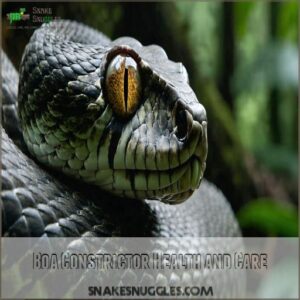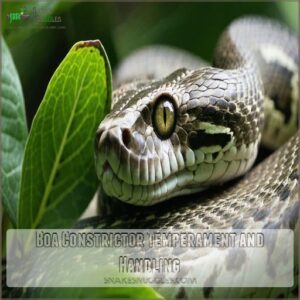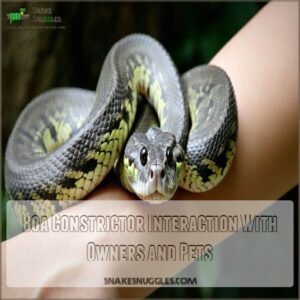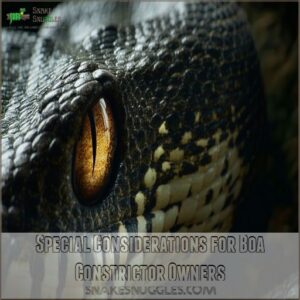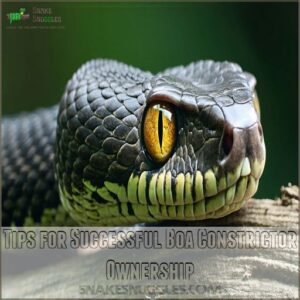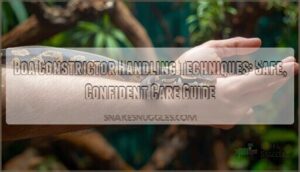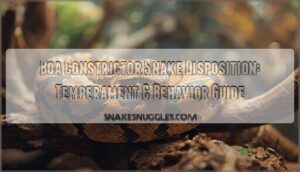This site is supported by our readers. We may earn a commission, at no cost to you, if you purchase through links.
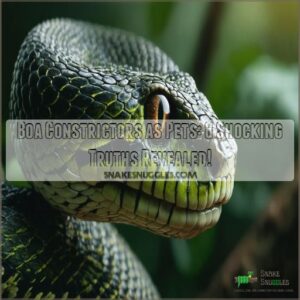
However, boa constrictors as pets also present challenges. They need a seriously large enclosure, specialized heating, and humidity control. Vet bills can be hefty, too.
Think of it like having a very chill, long-lived houseguest with specific needs. Are you prepared for the responsibility?
It’s a big decision, but we’ll help you navigate the details… We’ll cover everything from choosing the right snake to setting up the perfect habitat.
Table Of Contents
- Key Takeaways
- Benefits of Boa Constrictors as Pets
- Drawbacks of Boa Constrictors as Pets
- Choosing The Right Boa Constrictor as a Pet
- Boa Constrictor Housing and Environment
- Boa Constrictor Diet and Nutrition
- Boa Constrictor Health and Care
- Boa Constrictor Temperament and Handling
- Boa Constrictor Interaction With Owners and Pets
- Special Considerations for Boa Constrictor Owners
- Tips for Successful Boa Constrictor Ownership
- Frequently Asked Questions (FAQs)
- Do boa constrictors make good pets?
- Do boa constrictors like to be held?
- Are boa constrictors friendly to humans?
- What is the friendliest boa constrictor?
- How do boa constrictors behave during breeding season?
- What signs indicate a boa is shedding?
- Are boa constrictors safe for homes with children?
- Can boa constrictors be trained for specific behaviors?
- How do boas adapt to seasonal changes?
- Conclusion
Key Takeaways
- Boa constrictors are quiet and low-maintenance pets, but they need a large, well-maintained enclosure with precise heating and humidity control.
- They are docile and can tolerate regular handling, but they require patience, consistent care, and attention to stress signals.
- Owning a boa is a long-term commitment with potential costs for housing, food, and unexpected vet bills over a 20- to 30-year lifespan.
- Check local laws and permits before getting a boa, as regulations on exotic pet ownership differ by location.
Benefits of Boa Constrictors as Pets
If you’re searching for a pet that’s low-maintenance and uniquely enchanting, a boa constrictor might just be your perfect companion.
These gentle giants offer a long-lasting relationship.
A quiet presence and space-efficient lifestyle that can surprise even the most skeptical animal lover.
Long Lifespan and Low Maintenance
The longevity of boa constrictors offers a unique lifespan commitment that’ll intrigue dedicated pet owners.
Imagine a companion that’ll stick around for 20-30 years, requiring minimal daily maintenance compared to traditional pets.
Their low-maintenance nature means fewer vet visits, simple feeding routines, and straightforward care—perfect for reptile enthusiasts seeking a long-term, hassle-free pet experience. A long-term, hassle-free pet.
Gentle Nature and Handling
Surprisingly, one or two gentle boa constrictors can become your most docile reptilian companions.
Mastering safe interaction starts with understanding their boa constrictor temperament: slow, deliberate movements and consistent socialization tips make all the difference.
When you learn to read their stress signs and handle them confidently, these snakes transform from intimidating predators to surprisingly calm pets.
Relatively Quiet and Space-Efficient
Once you’ve mastered gentle handling, you’ll appreciate how boa constrictors shine as quiet companions perfect for tight spaces. These slithery friends won’t bark, chirp, or disrupt your peace—making them ideal for apartment dwellers.
Check out why boas rock as low-noise pets:
- Silent movement without vocal sounds
- Compact enclosure requirements
- Minimal daily interaction needs
- No constant maintenance demands
- Predictable behavioral patterns
Boa constrictors: your stealthy, space-saving reptilian roommates.
Drawbacks of Boa Constrictors as Pets
You might be surprised to learn that boa constrictors aren’t just exotic pets—they’re a major commitment that can catch you off guard.
Before bringing one home, you’ll need to carefully consider the significant challenges.
From specialized housing requirements to complex care needs that can test even experienced reptile enthusiasts.
Large Space and Housing Requirements
Wondering how much real estate a boa constrictor demands? Buckle up for a space-eating challenge.
These snakes aren’t your typical pet—their enclosure size can rival a small closet.
Expect a minimum 6-foot long habitat that’ll gobble up serious square footage.
Adult boas need substantial space to stretch, bask, and thrive, turning your room into their personal reptilian kingdom.
Specialized Care and Equipment Needs
Diving into boa constrictor care reveals a world of specialized equipment you’ll need to master.
From precise heating systems to humidity-controlled enclosures, these reptiles demand more than just a basic setup.
You’ll also need to carefully consider the ideal enclosure setup and sizing, such as a 2’L x 1.5’W x 1’H enclosure for baby boas.
You’ll invest in professional-grade thermostats, high-quality under-tank heaters, digital hygrometers, and multiple substrate options to create the perfect boa habitat.
It’s not just a pet—it’s a commitment.
Potential Health Issues and Veterinary Care
Boa constrictor health can be tricky and costly. Parasite treatment, respiratory infections, scale rot, and IBD prevention demand attention.
Veterinary care for snakes isn’t cheap, so budgeting for unexpected vet visits is wise.
Spotting issues early, like unusual breathing or sluggish behavior, helps.
Proper hygiene and husbandry go a long way in keeping reptile health—and your wallet—in good shape.
Choosing The Right Boa Constrictor as a Pet
Picking the right boa constrictor isn’t just about looks—it’s about finding a species that suits your lifestyle.
From size to temperament, choosing wisely can make all the difference for you and your scaly companion.
Researching Different Species and Morphs
So, you’re ready for a boa constrictor? Great!
Researching different boa constrictor species is key. Redtail boas and northern boas are popular choices.
Consider morph characteristics; they affect the price. Availability varies, so check with breeders.
Ethical sourcing matters. Knowing your options helps you choose the perfect pet.
Understanding Color Patterns and Prices
Have you noticed how diverse boa constrictors are? With endless color variations from redtail boas to rare morphs, there’s something for everyone.
Boa constrictor costs depend on species, rarity, and demand, with common northern boas priced modestly while rare morphs fetch thousands.
A value assessment guarantees fair pricing, so stay informed about market trends before purchasing.
Captive-Bred Vs Wild-Caught Boas
When picking boa constrictors, captive-bred snakes shine. They’re friendlier in temperament, thrive in reptile husbandry setups, and avoid disease risks often seen with wild-caught alternatives.
Ethical sourcing matters, plus captive boas adapt better to reptile ownership routines.
While wild-caught boas might seem tempting price-wise, you’ll face acclimation challenges and potential health issues.
Go captive-bred—it’s worth it.
Boa Constrictor Housing and Environment
To keep your boa constrictor healthy and comfortable, you’ll need to plan for a spacious, well-equipped enclosure.
Creating the right environment with proper heat, humidity, and hiding spots is essential for their well-being.
Enclosure Size and Material Options
Picking the right snake enclosure means balancing size, materials, and ventilation.
For your boa constrictor, aim for an enclosure matching its size—at least 6-8 feet long for adults.
Glass tanks, PVC cages, or wood enclosures work well, but consider cost and aesthetics too.
Ventilation is key to a healthy boa constrictor habitat, so double-check airflow.
Temperature Gradient and Heating Options
Temperature control is vital in your boa constrictor enclosure. Create a gradient to mimic their natural habitat using heat lamps and under-tank heaters.
When setting up heat mats, it’s important to remember using a boa heat mat from a reliable supplier, such as those found on boa heat mat options.
- Use thermostats to avoid overheating.
- Position heat mats carefully on one side of the tank for basking.
- Monitor temperatures regularly with a reliable thermometer to keep the warm side at 85-90°F and the cool side at 75-80°F.
Humidity Control and Substrate Selection
Maintaining the right temperature is only half the battle!
Now, let’s talk humidity. Your boa’s habitat needs the right moisture levels—around 50-70%. Use a hygrometer to check.
Good substrate choices include aspen shavings or coconut husk; avoid cedar or pine.
Proper enclosure ventilation is key, preventing mold.
Misting systems can help boost humidity, especially during shedding.
Remember, a happy boa is a healthy boa!
Boa Constrictor Diet and Nutrition
Feeding your boa constrictor the right diet is essential for its health.
Luckily, it’s simpler than you might think.
From rodents to proper feeding schedules, understanding their nutritional needs will keep your snake thriving.
Feeding Frequency and Prey Selection
Your boa constrictor’s feeding schedule depends on its age and size. Juveniles eat every 7-10 days; adults can wait 2-4 weeks.
Prey size matters—choose one no wider than the snake’s thickest part. Frozen-thawed options are safer.
Dietary supplements? Not needed with balanced prey.
Proper snake feeding is key for boa constrictor care and keeping pet snake nutrition on point.
Additionally, a boa constrictor feeding schedule should also be adjusted during cooler months, when feeding can be reduced to every 4-8 weeks.
Pre-Killed Vs Live Prey and Feeding Methods
Switching from feeding frequency to actual methods, should you offer pre-killed or live prey? Pre-killed provides safety and reduces stress during snake feeding.
Here’s the scoop:
- Pre-killed safety is unmatched—no injuries from struggling prey.
- Proper thawing methods guarantee prey is safe and warm.
- Match prey size to your boa’s widest point.
- Use handling techniques, not hands, for clean boa constrictor feeding.
Supplements and Nutritional Considerations
Regarding boa constrictor feeding, supplements aren’t usually necessary if prey variety meets dietary needs.
Whole prey typically provides balanced calcium and vitamins, keeping snake nutrition on point.
However, gut loading prey occasionally guarantees extra nutrients.
Watch for dietary issues like slow digestion, and avoid over-supplementing—it’s like giving them dessert when they’re already full!
Boa Constrictor Health and Care
Keeping a boa constrictor healthy means recognizing common issues like respiratory infections and mites.
Regular vet visits and proper care go a long way in preventing problems before they start.
Ensuring their environment stays clean is also crucial.
Common Health Issues and Symptoms
Feeding’s done, but what about spotting health problems?
Common boa constrictor health issues include respiratory infections, scale rot, and parasite infestations.
Watch for IBD symptoms like lethargy or loss of muscle control.
Preventative care matters—keep enclosures clean and humidity stable. A wheezing snake or dull scales isn’t just moody; it’s a signal their health needs attention ASAP! Preventative care matters.
Veterinary Care and Regular Check-Ups
Finding a reptile vet is key for your boa constrictor care.
Preventative care is cheaper than treating diseases.
Regular check-ups help spot early disease symptoms.
Treatment options vary, impacting cost estimates.
If you’re searching for a boa vet near you, online platforms like Chewy’s boa vet finder can be useful resources.
Your vet can advise on snake health and boa constrictor care.
Pet health is seriously impacted without veterinary care.
Quarantine and Isolation Procedures
Starting with quarantine is smart boa constrictor care.
Keep new snakes isolated 30-90 days in a simple enclosure to monitor for parasites or disease signs. This period acts as an essential surveillance system for potential threats.
Skip shared gear between snakes. Watch for odd behavior or respiratory issues.
After quarantine duration, move to regular housing with post-quarantine care routines. It’s key for snake health and safe reptile care.
Boa Constrictor Temperament and Handling
Boa constrictors are usually calm pets.
Handling them takes patience and awareness.
You’ll need to watch for stress signals like hissing or striking and always support their body for safe interaction.
Gentle Handling and Socialization Techniques
Handling your boa constrictor is all about patience and reading body language cues.
Slow introductions help build trust; think of it like earning a shy friend’s confidence.
Use positive reinforcement—gentle, regular interaction encourages calm behavior.
Always support the snake’s body to guarantee comfort. Practicing safe handling practices protects you but also keeps your snake feeling secure.
Recognizing Stress and Defensive Behavior
How can you tell your boa is stressed? Watch for behaviors like hissing sounds, rapid escape attempts, or stiff defensive postures.
Body language speaks volumes—coiling tightly or striking suggests agitation.
Understanding boa constrictor behavior helps you adjust its environment or handling. A calm snake displays relaxed movements; anything else might signal stress.
Learn your snake’s temperament to handle challenges with ease.
Safe Handling Practices and Precautions
Spotting stress signs helps you avoid spooking your boa.
Use slow movements and firm lifting techniques to support its body fully.
Practice snake handling safety by keeping your snake away from your face and never handling it after feeding. Enclosure safety matters too—always secure the lid.
Regular handling frequency builds trust and prevents defensive behavior, boosting snake bite prevention. Regular handling helps.
Boa Constrictor Interaction With Owners and Pets
You’ll learn how to safely introduce your boa constrictor to other pets and people.
Remembering that gentle handling and understanding their needs are key to a harmonious co-existence.
We’ll cover essential safety precautions and supervision techniques to guarantee everyone—including your scaly friend—stays safe and happy.
Socialization and Interaction Techniques
Building trust with your boa constrictor takes patience.
Use gentle handling during its nocturnal interaction periods when it’s naturally active.
Watch for stress signs like hissing or defensive strikes, and back off if needed. Positive reinforcement, like creating stress-free environments, helps develop safe interactions.
Understanding the importance of providing a suitable enclosure with proper heating, humidity, and hiding spots is also key for building trust.
Always support its body fully during handling to guarantee comfort and understand its unique snake behavior for smoother bonding.
Introducing Boas to Other Pets and People
Meeting new people and pets can be tricky for your boa.
Start with safe introductions, focusing on gradual exposure and controlling species compatibility.
Monitor the snake’s temperament and behavior closely. Avoid direct contact between your boa and other animals, as potential risks are higher.
Educate yourself on responsible boa ownership to reduce stress for both your snake and those around it. Safe introductions and responsible boa ownership are key.
Safety Precautions and Supervision
Boa constrictor ownership requires prioritizing safety. Make enclosure security airtight to prevent escapes.
Always supervise interactions with kids or pets.
Use proper snake handling techniques to minimize bite risk and support snake safety.
Child safety comes first—teach boundaries and handling tips.
Escape prevention isn’t just smart; it’s essential for responsible boa constrictor handling.
Special Considerations for Boa Constrictor Owners
Owning a boa constrictor means understanding the legal, financial, and lifelong responsibilities that come with it.
You’ll need to plan ahead for decades, including budgeting for food, housing, and vet care.
Local Regulations and Laws
Before you bring home one of these pet snakes, check your area’s laws. Boa constrictor ownership isn’t always straightforward, especially with species restrictions and permit requirements varying by location.
- Local regulations banning exotic pets.
- Permit requirements for legal ownership.
- Import/export rules for boa constrictors.
- Ethical considerations of exotic pet trade.
- Consequences of non-compliance.
Here’s what to think about:
- Make certain you have the necessary boa constrictor permits to avoid legal issues.
Long-Term Commitment and Responsibility
Owning a boa constrictor is a marathon, not a sprint! This pet snake demands a serious time commitment; their lifespan averages 20-30 years.
Are you truly emotionally ready for such a long-term commitment?
Ethical sourcing is key; confirm your new friend comes from a reputable breeder.
Responsible boa constrictor ownership means understanding pet responsibilities and future planning. Consider the pet snake care involved before diving in.
Financial Considerations and Budgeting
Boa constrictor ownership isn’t just a commitment of time—it’s a financial obligation too.
Initial costs, like enclosures and heating, can sting your wallet, while ongoing expenses for food and substrate add up.
Unexpected costs, like vet visits, make planning a savings plan smart.
For all the boa constrictor pros, budgeting for pet care is essential to avoid surprising boa constrictor cons later.
Tips for Successful Boa Constrictor Ownership
Owning a boa constrictor means staying patient, well-prepared, and consistent with its care. With the right effort, you’ll keep your snake healthy and thriving for decades.
Research and Preparation
Preparation smooths the path to boa ownership. Start with species selection and research each boa constrictor’s size, lifespan, and temperament. Understand dietary needs—you’ll be feeding frozen rodents, not kibble! Also, consider the ideal humidity control, aiming for 60-75%.
- Know local legal aspects of owning a boa.
- Plan your enclosure setup—space and heating.
- Calculate the long-term cost analysis.
- Favor captive-bred boas over wild-caught.
Patience and Understanding
Taking on a boa constrictor pet means mastering patience. These snakes move at their pace, not yours.
Understand their temperament, recognize stress signs like hissing or striking, and use proper handling techniques to build trust. They’re not puppies; they need calm, consistent care.
Here’s a quick cheat sheet:
| Handling Tips | Stress Signs | Owner Traits |
|---|---|---|
| Slow, gentle moves | Hissing, striking | Calm |
| Support whole body | Avoids handling | Observant |
| No sudden actions | Restlessness | Patient |
Regular Maintenance and Upkeep
Keeping up with a boa constrictor’s needs demands consistency.
Regular maintenance helps guarantee their health:
- Enclosure cleaning to remove waste and bacteria.
- Substrate changes every few weeks to maintain hygiene.
- Water bowl hygiene with daily cleaning to prevent contamination.
- Temperature checks and humidity levels adjusted regularly for accurate conditions.
Reliable boa constrictor care and maintenance create a happier, healthier pet.
Frequently Asked Questions (FAQs)
Do boa constrictors make good pets?
Boa constrictors can make great pets if you’re prepared for their size, long lifespan, and specific care needs.
They’re generally docile and fascinating to watch, but they require commitment, proper handling, and a well-maintained environment.
Do boa constrictors like to be held?
Think of boa constrictors like introverted roomies—they tolerate handling but don’t crave it.
They prefer being left alone most of the time, though regular, gentle handling helps them stay calm and less defensive with you.
Are boa constrictors friendly to humans?
You might be surprised to learn that boa constrictors are generally docile.
They can strike if threatened, so handling them gently and carefully is essential.
What is the friendliest boa constrictor?
The Colombian boa (Boa imperator) is often considered the friendliest.
With consistent handling and proper care, it’s known for its calm, docile nature, making it a great choice for beginners and experienced keepers alike.
How do boa constrictors behave during breeding season?
During breeding season, males become more active, searching for females. Females become receptive, often displaying specific behaviors. Mating involves the male wrapping around the female. After mating, females lay eggs.
What signs indicate a boa is shedding?
Cloudy or bluish eyes, dull skin, reduced appetite, and increased hiding are clear signs a boa’s shedding process is underway.
Expect your snake to rub against objects to loosen its old skin before peeling.
Are boa constrictors safe for homes with children?
Don’t worry, boa constrictors can be safe if you’re careful.
They’re docile but need supervision with kids.
Teach handling rules, guarantee secure enclosures, and avoid interaction during feeding times to minimize risks.
Can boa constrictors be trained for specific behaviors?
You can’t really “train” a boa constrictor like a dog.
They can get used to handling routines and predictable environments.
With regular interaction, they’ll associate you with safety and stay calmer when handled.
How do boas adapt to seasonal changes?
Imagine adjusting your wardrobe for winter and summer—boas do the same with their environment.
In the wild, they respond to seasonal changes by adjusting activity levels, breeding behaviors, and sometimes eating less during cooler months.
Conclusion
Choosing boa constrictors as pets might seem unusual, but it’s all about finding the right fit for your lifestyle.
With their long lifespan, quiet nature, and unique charm, boas can be rewarding companions if you’re ready for the commitment.
However, the challenges – like housing, specialized care, and cost – shouldn’t be ignored.
By exploring the pros and cons, you can decide whether their fascinating presence outweighs the responsibilities. Are you ready to meet these long-term, scaly houseguests?

